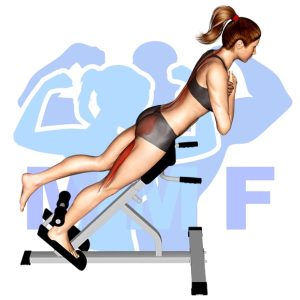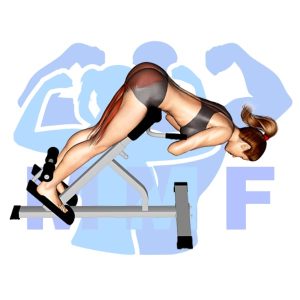Are you tired of doing endless crunches that yield little to no results? Have you considered incorporating the scissor crunch into your routine? Many people struggle with achieving toned and defined abs, despite their best efforts. This can be due to a lack of variety in ab exercises, causing boredom and muscle plateau. Don’t fret, though – incorporating the scissor crunch into your routine can provide the variation needed to target those hard-to-reach muscles. In this post, we will break down the scissor crunch and provide tips on how to maximize its benefits for achieving your dream abs.
Scissor Crunch Summary
- Primary Muscles: Rectus Abdominis
- Secondary Muscles: Obliques
- Equipment: Body Weight
- Mechanics Type: Isolated
- Force: Pull
- Utility: Auxiliary

Scissor Crunch Instructions
- Setup by laying supine, back down, on a bench or mat.
- Place your hands behind your head.
- Raise your shoulders off the mat and raise one leg vertically with your knee nearly straight.
- If lying on the floor, raise the other leg slightly off of the floor. Keeping your knees nearly straight, simultaneously changing the positions of your legs, so you lower your vertical leg while you raise your lower leg vertically.
- Continue alternating leg positions. Also known as Scissors Kick while holding the crunch.
Video Tutorial
Scissor Crunch Muscles
Target (Agonist)
Synergists
Dynamic Stabilizers
- None
Stabilizers
Antagonist Stabilizers
- None

Benefits of Scissor Crunch
The scissor crunch exercise is an effective way to strengthen the rectus abdominis, which is the most visible muscle in the abdominal area. This exercise targets the rectus abdominis, helping to develop strong and toned abdominal muscles. The movement of the scissor crunch engages the rectus abdominis by requiring it to contract and lift the torso up and down. Additionally, the scissor crunch focuses on the lower abs, which can be difficult to target with other exercises. Performing this exercise regularly can help to improve posture, decrease lower back pain, and reduce the risk of injuries.
Tips for Performing Scissor Crunch
If you’re seeking to take your scissor crunch to a new level, then you’ve come to the right place. These tips will help you get the most from of this beautiful workout, and help you receive all the benefits it has to offer. Concurrently with shaping your stomach muscles, increasing mobility, and even a reduced possibility of injury can all be accomplished with this exercise. So let’s get started and look at what these tips can do for you.
- Always keep your core tight – Keeping your core engaged while performing the scissor crunch will help you maximize the effectiveness of the exercise and will also help protect your spine from injury.
- Make sure your range of motion is complete – It is important to make sure you are fully extending and contracting your abs for the full range of motion in order to get the most out of the exercise. This will help you strengthen and tone your core muscles.
- Keep your breathing steady – Breathing steadily while performing the scissor crunch helps to keep your core stable and engaged, which will help you get the most out of the exercise. Additionally, it will help keep your heart rate up and ensure you are getting a good cardio workout.
Benefits and Tips Video
Frequent Mistakes To Avoid
When performing scissor crunch, keeping away from typical mistakes can be the difference to achieving optimal results and avoiding injury. Additionally, achieving optimal results from this exercise requires appropriate form, and making sure you don’t perform typical mistakes can help you to perform the exercise correctly and obtain optimal results. But relax, it’s not as challenging as it might seem. By knowing the mistakes to avoid and taking the right actions, you can execute the activity securely and effectively. So it is time for you to optimize the impact of this exercise and enjoy the advantages of a successful workout.
- Not engaging their core muscles: It is important to engage your core muscles when doing the scissor crunch, as it helps to stabilize your body and target the right muscles for toning.
- Not keeping their neck aligned: Keeping your neck in line with your spine helps to protect it from injury and allows you to get the most out of the exercise.
- Not controlling the movement: Allowing momentum to take over can lead to incorrect form, resulting in less effective toning and possible injury. Therefore, it is important to control the movement throughout the exercise.
Find More Bodyweight Exercises Here
Variations and Complementary Exercises
If you’re looking for ways to mix up your Scissor Crunch routine, or just want to target the same muscles in different ways, try out these variations, complements, or alternatives.
Roll Ups

Roll Ups are an excellent alternative or complementary exercise for the Scissor Crunch. This exercise is designed to work your core muscles and increase stability, strength, and balance. Roll Ups involve lying flat on your back with your arms outstretched in front of you and your legs straight. Slowly roll your torso up so that your head, shoulders, and arms come off the ground, then slowly roll back down. This exercise targets the abdominal and oblique muscles, which are important for stabilizing the body when performing the Scissor Crunch. The Roll Up also helps to improve flexibility and mobility in the spine, making it an ideal complement to the Scissor Crunch.
Roll Up Crunch

Roll Up Crunch is a great alternative or complementary exercise to Scissor Crunch. This exercise targets the same muscle group, but is much less intense and requires less coordination. The Roll Up Crunch involves lying on your back with your arms extended above your head and your legs out straight. Then, you simply roll up, bringing your chest off the ground, and then roll back down. This exercise is great for working the lower abdominal muscles, which are essential for core strength and stability. It is also a great way to add variety to your core routine.
Reverse Crunch

The reverse crunch is a great complementary or alternative exercise to the scissor crunch. This abdominal exercise focuses on the lower abs and obliques, while the scissor crunch targets the upper abs and obliques. To do a reverse crunch, lie flat on your back with your hands behind your head. Raise your feet off the ground, keeping them together. Then, raise your hips off the ground until your knees are pointing towards your chest. Lower yourself back down and repeat. The reverse crunch is an effective way to target the lower abdominal muscles and increase core strength.
Check Out These Top Bodyweight Exercises
Plank Hip Lift

The Plank Hip Lift is a great alternative or complementary exercise to the Scissor Crunch. It is an effective way to target the same core muscles as the Scissor Crunch, but without the strain on your neck and back. To perform the Plank Hip Lift, start in a plank position with your hands and feet on the ground, then lift one leg at a time up towards your chest and back down. This exercise engages your abdominals, obliques, and glutes while improving posture and balance. Additionally, this exercise can be modified to make it easier or more difficult depending on your fitness level.
Plank

Plank is an exercise that can be used as a complementary or alternative exercise to the scissor crunch. It is an effective core exercise that works to strengthen the abdominal muscles and can be used to improve balance and posture. Plank is a full-body exercise that requires you to hold your body in a straight line from head to toe, and it is an isometric exercise, meaning that you don’t move, but instead hold your body in the same position for a set amount of time. This type of exercise challenges your core muscles and helps build strength and stability.
Lying Straight Leg Raise

The Lying Straight Leg Raise is a great complementary or alternative exercise to the Scissor Crunch. It works the same muscles, specifically the lower abdominals, but in a different way. With the Lying Straight Leg Raise, you lie on your back and raise your legs straight up towards the ceiling. This puts more emphasis on the lower abdominal muscles and helps to engage them more effectively than when doing a Scissor Crunch. It’s an excellent way to add variety to your ab workout and target those lower abs.
Find More Abs Exercises Here
Opposing Complementary Exercises
To further build strength in your core, it’s important to work the opposing muscle groups as well. The following exercises can be used to complement the Scissor Crunch and help you achieve a stronger and more balanced core.
45 Degree One Leg Hyperextension

The 45 Degree One Leg Hyperextension is an excellent exercise for strengthening the muscles of the lower back, glutes, and hamstrings. This exercise is complementary to the Scissor Crunch, which works the abdominal muscles, because it utilizes the opposing muscle group. It is important to maintain good form while performing this exercise to ensure that you are targeting the correct muscles and to prevent injury. By performing both exercises together, you will be able to target all the muscles of your core and lower body, and you will be able to achieve a more complete workout.
45 Degree Hyperextension

The 45 Degree Hyperextension is a great exercise to pair with the Scissor Crunch for a complete abdominal workout. By targeting the lower back muscles, it helps to strengthen and tone the opposing muscle group of the abdominals. It also helps to keep the spine in proper alignment and improve core stability. Performing this exercise will help to balance out the strength between the lower back and abdominals, helping to prevent injury or strain when performing other exercises.
Straight Leg Cable Pull Through

The Straight Leg Cable Pull Through is a great complementary exercise to the Scissor Crunch. This exercise primarily works the glute and hamstring muscles, whereas the Scissor Crunch primarily works the abdominal muscles. By performing both exercises, you are able to effectively target both muscle groups for a more balanced and complete workout. Additionally, since the Straight Leg Cable Pull Through is a compound exercise that involves multiple muscle groups, it helps to engage other muscles in your legs and core that are not used in the Scissor Crunch. This helps to create a more dynamic and effective workout.
Sculpt Your Abs with Scissor Crunch
Looking for a way to take your ab workouts to the next level? Scissor crunches may be just what you need. This exercise targets your rectus abdominis, the muscle responsible for creating the coveted six-pack look. Scissor crunches don’t require any equipment, making them the perfect addition to a home workout routine. The key to the perfect scissor crunch is slow, controlled movements. Remember to engage your abs throughout the exercise and breathe evenly to get the most out of each rep. Incorporate scissor crunches into your ab routine and see the results for yourself!
References: Wikipedia | ExRx.net | PubMed.gov | Comprehensive List of Abs Bodyweight Exercises

